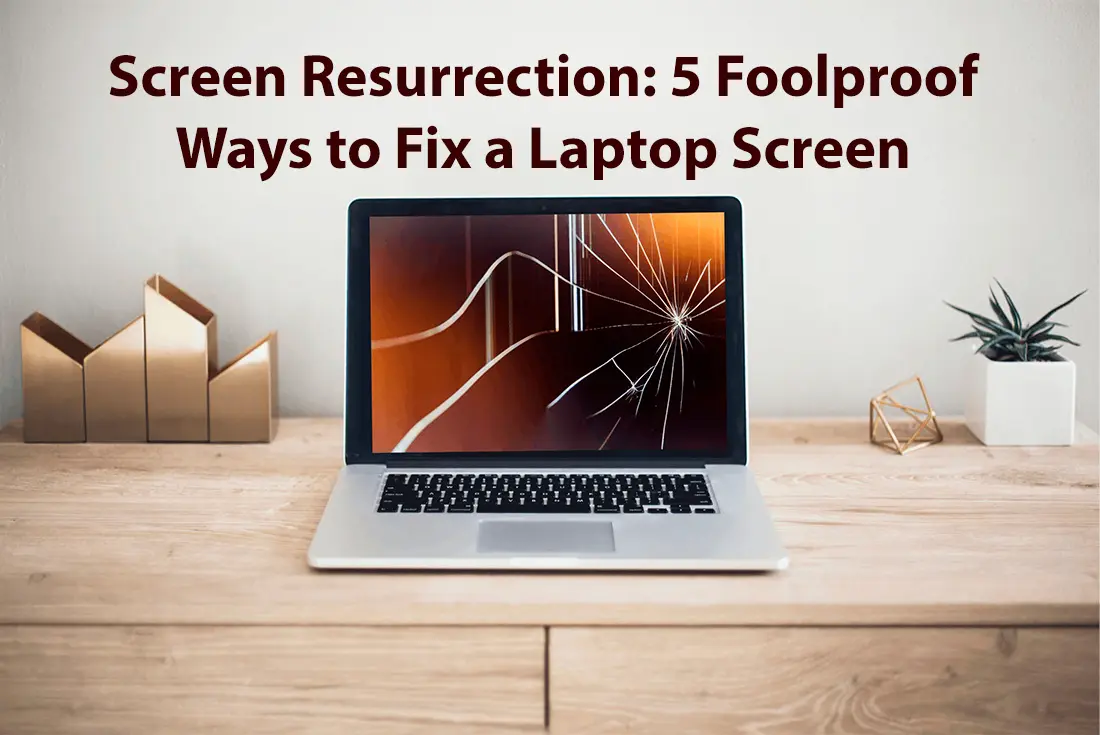
11 Mar Screen Resurrection: 5 Foolproof Ways to Fix a Laptop Screen
Is your once vibrant laptop screen now a victim of flickering, dimness, or even complete darkness? Fear not, for this guide equips you with the knowledge to resurrect your laptop display. We’ll explore five foolproof methods, ranging from simple adjustments to more involved repairs, to get your screen functioning flawlessly once again.
Whether you’re dealing with a software glitch or a hardware issue, this comprehensive guide empowers you to troubleshoot and fix your laptop screen yourself. From adjusting display settings to replacing the screen entirely, we’ll equip you with the steps and knowledge to conquer any display woe.
So, ditch the frustration and embark on a screen resurrection mission with this informative guide!
Method 1: Adjusting Display Settings to Fix a Laptop Screen
A dim, flickering, or incorrectly scaled display can often mask as a severe screen issue. Before you consider hardware solutions, adjusting your laptop’s display settings is a straightforward and effective first step. This method can resolve common display problems, saving time and resources.
Accessing Display Settings: A Step-by-Step Guide
- Open Display Settings: Right-click on your desktop and select “Display settings” from the context menu. Alternatively, press Windows Key + I to open Settings, and navigate to System > Display.
- Adjust Brightness and Color: Look for the brightness slider to adjust your screen’s brightness. If your screen colors seem off, locate the “Color calibration” tool to fine-tune color balance and saturation.
Key Settings to Check and Modify
- Resolution: Ensure your display resolution matches the recommended settings for your screen. Incorrect resolution can cause blurry or stretched images.
- Scale and Layout: If text, apps, or other items appear too small or too large, adjust the scale setting. A setting of 100% is standard, but you may need to experiment to find the best fit for your screen size.
- Refresh Rate: A low refresh rate can lead to screen flickering. Navigate to Advanced display settings > Display adapter properties, and set the highest available refresh rate for your display.
Troubleshooting Tips
If adjusting display settings does not resolve your issue, consider the following:
- Update Graphics Drivers: Outdated or corrupted graphics drivers can cause display issues. Check the manufacturer’s website for the latest driver software.
- External Monitor Test: Connect your laptop to an external monitor. If the display issue persists on the external screen, the problem might be related to your graphics card rather than the laptop screen.
- Hardware Check: For persistent problems after software adjustments, a hardware issue like a loose display cable might be at fault. Consult a professional for a thorough inspection.
Downtown Computer Services is the best computer maintenance and repair place in Fort Lauderdale. We’ve been serving the community for almost 30 years, repairing both Macs and PCs, laptop and desktops. Our experienced IT specialists are at your service: diagnostics, repair, software setup, security issues, hardware sales, and more. So, your computer is in trouble? Dial (954) 524 9002 and let Downtown Computer Services take care of it.
Method 2: Checking and Reconnecting Display Cables
Loose or disconnected display cables are common culprits behind screen issues in laptops. This method focuses on ensuring secure cable connections for optimal screen performance. Before proceeding, ensure your laptop is powered off and unplugged to avoid any risk of electric shock.
Significance of Secure Cable Connections
A loose connection can disrupt the signal between your laptop’s motherboard and its screen, leading to various display problems, from flickering to complete blackout. Ensuring each cable is securely connected is crucial for a stable display output.
Safely Opening Your Laptop
- Gather Necessary Tools: You’ll need a small Phillips-head screwdriver and possibly a plastic pry tool.
- Remove the Battery: If your laptop has a removable battery, take it out to ensure safety.
- Unscrew the Back Panel: Carefully unscrew the back panel of your laptop. Keep screws in a safe place to avoid losing them.
- Locate the Display Cables: Once inside, you’ll find the display cable typically located near the laptop’s hinge. It’s usually a thick cable running from the motherboard to the screen’s back.
Proper Cable Reconnection Techniques
- Check for Damage: Before reattaching, inspect the cable and connectors for any signs of damage. If you notice fraying or tears, the cable may need replacing.
- Reconnect with Care: Gently push the cable into its connector until it’s securely seated. If there’s a locking mechanism, ensure it’s properly engaged.
- Test Before Reassembling: Before screwing the back panel on, connect your laptop to power and turn it on to test the screen. If the display looks correct, proceed to reassemble.
Method 3: Updating Graphics Drivers
Outdated or corrupt graphics drivers are often at the heart of laptop screen issues. This method delves into the crucial role drivers play in screen performance and provides a step-by-step guide to updating them.
The Role of Drivers in Screen Performance
Graphics drivers facilitate communication between your laptop’s operating system and its graphics hardware. Up-to-date drivers ensure this communication is seamless, supporting optimal screen resolution, color accuracy, and overall display performance.
Identifying and Updating Outdated Drivers
- Access Device Manager: Press the Windows key + X and select Device Manager from the menu.
- Expand Display Adapters: Locate and click on “Display adapters” to reveal your graphics hardware.
- Check for Updates: Right-click on your graphics card and select “Update driver”. Choose “Search automatically for updated driver software” and follow the prompts.
If an update is available, Windows will download and install it automatically. Restart your laptop to apply the update and check if the screen issue is resolved.
Additional Troubleshooting Tips
- Manufacturer’s Website: If Windows doesn’t find an update, visit the graphics card manufacturer’s website (e.g., NVIDIA, AMD, Intel). They often have the latest drivers available for direct download.
- Reinstall the Driver: Sometimes, a fresh installation is needed. In Device Manager, right-click on your graphics card, select “Uninstall device”, then download and install the latest driver from the manufacturer’s website.
- Adjust Graphics Settings: After updating, tweaking graphics settings through the dedicated software (NVIDIA Control Panel, AMD Radeon Settings) can further optimize screen performance.
Method 4: Using External Display Options
When a laptop screen fails, you can use external monitors or TVs. This approach not only bypasses the faulty screen but also offers a larger and more versatile display setup.
Introduction to External Displays
Connecting your laptop to an external monitor or TV can extend or mirror your existing display. This setup is ideal for presentations, expanded workspaces, or even as a temporary fix for screen issues.
Connecting and Configuring External Devices
- Identify Compatible Ports: Check your laptop for HDMI, VGA, DisplayPort, or USB-C ports. Your external display will need a corresponding input.
- Select the Right Cable: Use a cable that matches the ports on both your laptop and the external display. For modern setups, HDMI or USB-C is preferable due to their support for high-resolution video and audio.
- Connect the Devices: Power off your laptop, connect one end of the cable to your laptop and the other to the external display. Power on both devices.
- Configure Display Settings: Press Windows key + P to open display settings. Choose from “Duplicate”, “Extend”, “Second screen only”, or “PC screen only” based on your needs.
- Adjust Resolution and Orientation: Right-click on your desktop, select “Display settings”, and adjust the resolution and orientation to fit your external monitor’s specifications.
Tips for Maximizing Display Quality and Settings
- Update Graphics Drivers: Ensure your graphics drivers are up-to-date for optimal compatibility and performance with external displays.
- Use High-Quality Cables: Investing in high-quality cables can prevent video or audio degradation.
- Adjust Monitor Settings: Many monitors have built-in menus for adjusting brightness, contrast, and color. Experiment with these settings to achieve the best display quality.
- Consider Screen Mirroring Devices: For wireless connectivity, devices like Chromecast or Apple TV can mirror your laptop’s display to a TV without cables.
Method 5: Replacing the Laptop Screen
When faced with severe screen damage, such as deep cracks or persistent display issues, replacing the laptop screen becomes the most effective solution.
When is Screen Replacement Necessary?
Screen replacement is advisable when simple fixes fail to resolve display problems. Signs that necessitate this approach include irreversible physical damage, dead pixels in large numbers, or persistent screen glitches that hinder normal operation.
Finding and Purchasing a Compatible Replacement Screen
- Identify Your Laptop Model: Check your laptop’s underside or within its settings to find the exact model number.
- Search for a Compatible Screen: Use your laptop model number to search for compatible replacement screens. Online marketplaces, manufacturer websites, or specialized electronics stores are excellent sources.
- Verify Specifications: Ensure the replacement screen matches your laptop’s size, resolution, and connector type. Accuracy is crucial for compatibility and optimal performance.
Step-by-Step Guide on Replacing the Screen
- Prepare Your Workspace: Gather necessary tools such as screwdrivers and a small container for screws. Work in a clean, static-free environment.
- Power Down and Disassemble: Turn off your laptop, disconnect the power cord, and remove the battery. Carefully remove the bezel by unscrewing and gently prying it off.
- Remove the Damaged Screen: Detach any screws securing the screen to the frame. Gently disconnect the video cable and remove the damaged screen.
- Install the New Screen: Place the new screen into the frame. Connect the video cable and secure the screen with screws. Ensure connections are firm but not overly tight.
- Reassemble and Test: Replace the bezel and reinsert any screws. Reconnect the battery and power cord. Turn on your laptop to test the new screen’s functionality.
Tips for Success
- Handle with Care: Screens are fragile. Handle the new screen by its edges and avoid touching the surface.
- Keep Track of Screws: Laptop screws are small and easy to lose. Use a container to keep them safe during the process.
- Consult a Tutorial: For specific models, consulting a video tutorial or guide can provide valuable insights and prevent mistakes.
Conclusion
Don’t let a malfunctioning laptop screen hinder your productivity! This guide has empowered you with the knowledge and tools to resurrect your display and get back to business.
We’ve explored a range of solutions, from simple software adjustments to screen replacements. Whether you’re a seasoned techie or a complete novice, you’re now equipped to troubleshoot and fix common display issues with confidence.
Remember:
- Start with the simplest fixes first, like adjusting display settings or updating drivers.
- If the problem persists, consider using an external monitor as a temporary solution.
- For severe screen damage, replacing the screen is the most effective option.
With the information in this guide, you can approach any screen woe with a solution-oriented mindset. So, ditch the frustration and embark on your screen resurrection mission today! Or call Downtown Computer Services — your go-to for reliable, comprehensive, and swift computer repair services. Dial: (954) 524 9002 to learn more.
Check out other relevant news
- How Easy-to-Use Hacking Tools Are Fueling Cybercrime
- Cryptocurrency Security for Small Businesses: Protecting Your Wallet
- The Infostealer Epidemic: Protecting Your Business from the Latest Wave of Cyberattacks
- The Identity Crisis: How Compromised Credentials Can Cripple Your Business
- Beyond the Brick and Mortar: Building Your Online Storefront with Digital Marketing
